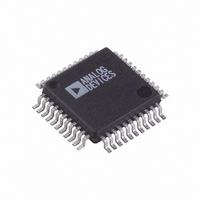AD7841AS Analog Devices Inc, AD7841AS Datasheet - Page 9

AD7841AS
Manufacturer Part Number
AD7841AS
Description
IC DAC 14BIT OCTAL VOUT 44-MQFP
Manufacturer
Analog Devices Inc
Datasheet
1.AD7841ASZ-REEL.pdf
(13 pages)
Specifications of AD7841AS
Rohs Status
RoHS non-compliant
Settling Time
31µs
Number Of Bits
14
Data Interface
Parallel
Number Of Converters
8
Voltage Supply Source
Analog and Digital, Dual ±
Power Dissipation (max)
303mW
Operating Temperature
-40°C ~ 85°C
Mounting Type
Surface Mount
Package / Case
44-MQFP, 44-PQFP
For Use With
EVAL-AD7841EBZ - BOARD EVAL FOR AD7841
Available stocks
Company
Part Number
Manufacturer
Quantity
Price
Company:
Part Number:
AD7841AS
Manufacturer:
AD
Quantity:
5 510
Company:
Part Number:
AD7841ASZ
Manufacturer:
Analog Devices Inc
Quantity:
10 000
Part Number:
AD7841ASZ
Manufacturer:
ADI/亚德诺
Quantity:
20 000
Company:
Part Number:
AD7841ASZ-REEL
Manufacturer:
Analog Devices Inc
Quantity:
10 000
REV. B
Power-On with CLR Low
The output stage of the AD7841 has been designed to allow
output stability during power-on. If CLR is kept low during
power-on, then just after power is applied to the AD7841, the
situation is as depicted in Figure 5. G
while G
V
G
parallel with the gain resistors of the output amplifier. The
output amplifier is connected as a unity gain buffer via G
the DUTGND voltage is applied to the buffer input via G
amplifier’s output is thus at the same voltage as the DUTGND
pin. The output stage remains configured as in Figure 5 until
the voltage at V
–3 V. By now the output amplifier has enough headroom to
handle signals at its input and has also had time to settle. The
internal power-on circuitry opens G
G
fier is configured in its noise gain configuration via G
The DUTGND voltage is still connected to the noninverting
input via G
V
opening of G
via the configuration shown in Figure 6.
When CLR is taken back high, the output stage is configured as
shown in Figure 7. The internal control logic closes G
opens G
gain-of-two configuration. The voltage that appears on the V
pins is determined by the data present in the DAC registers.
OUT
OUT
5
6
. This situation is shown in Figure 6. Now the output ampli-
and a 14 kΩ resistor. This thin-film resistor is connected in
is kept within a few hundred millivolts of DUTGND via
has been disconnected from the DUTGND pin by the
2
DAC
DAC
2
, G
. The output amr})fier is connected in a noninverting
2
3
and this voltage appears at V
5
and G
, but will track the voltage present at DUTGND
DD
G
G
G
G
1
1
2
2
5
exceeds 7 V and V
are closed.
DUTGND
DUTGND
R
R
G
G
4
4
G
G
G
G
3
5
3
5
R
R
3
14k
14k
and G
1
, G
SS
G
G
6
is more negative than
OUT
6
4
and G
5
and closes G
.
6
are open
4
V
V
OUT
and G
OUT
2
. The
1
3
CLR
, and
4
and
CLR
and
OUT
6
.
Power-On with CLR High
If CLR is high on the application of power to the device, the
output stages of the AD7841 are configured as in Figure 8 while
V
closed and G
DAC to the input of its output amplifier. G
while G
a unity gain buffer. V
through a 14 kΩ resistor until V
negative than –3 V.
When the difference between the supply voltages reaches 10 V,
the internal power-on circuitry opens G
and G
DD
is less than 7 V and V
6
4
configuring the output stage as shown in Figure 9.
DAC
DAC
DAC
and G
2
is open, thereby connecting the output of the
6
are open, thus connecting the output amplifier as
G
G
G
G
G
G
1
1
1
2
2
2
OUT
DUTGND
DUTGND
DUTGND
R
R
R
is connected to DUTGND via G
G
G
SS
G
4
4
4
is more positive than –3 V. G
DD
G
G
G
G
G
G
3
5
3
5
3
5
exceeds 7 V and V
R
R
R
14k
14k
14k
CLR
3
G
G
G
and G
6
6
6
3
and G
5
AD7841
CLR
CLR
and closes G
5
are closed
V
V
V
SS
OUT
OUT
OUT
is more
1
5
4
is













